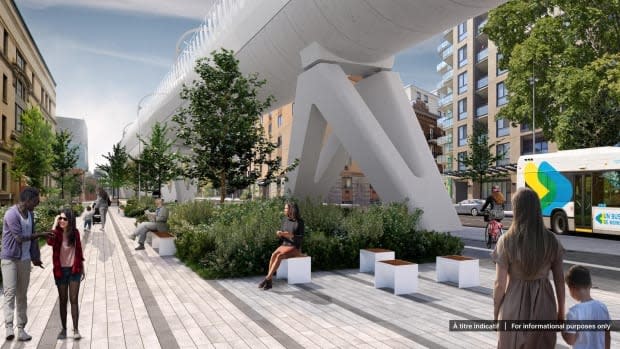Quebec takes over REM de l'Est project after CDPQ Infra backs out

After butting heads with the creators of the REM de l'Est over a plan to install elevated tracks in Montreal's downtown core, Premier François Legault announced that the Quebec government will be taking over the massive public transit project and scrapping its downtown portion.
The original developer, CDPQ Infra — a subsidiary of Quebec's pension fund manager, the Caisse de dépôt et placement du Québec — is now out. Legault and Montreal Mayor Valérie Plante made the announcement on Monday at a news conference.
Legault said the plan to have elevated tracks did not gain "social acceptability." The province will also explore other major changes as well.
Without the elevated platforms, the project, which came with an initial price tag of $10 billion, is no longer viable for CDPQ Infra, the premier said. He also added that he understands why the developer would no longer want to proceed.
It's not yet clear how these major changes will affect the project's price tag and timeline. The REM de l'Est was first supposed to be completed in 2029.
"People that know me know that I don't have a lot of patience and I want this project to be completed as quickly as possible," Legault said.
"It is crucial for the development of the east end of Montreal."
WATCH | Quebec premier explains why province is stepping in:
On Monday, Plante described the initial plan to have elevated tracks in the eastern part of downtown as a "historic mistake that absolutely had to be avoided."
Plante's concerns were echoed by a report from an expert advisory committee, which said the elevated platforms would be an eyesore and would "fracture" the urban landscape. There were also concerns it would erode the quality of life in nearby neighbourhoods, including the city's historic Chinatown.

Montreal's mayor has long been pushing for the city to have a heavier hand in shaping the public transit project.
Moving forward, the major partners working with the province will be the regional transit planning agency for the greater Montreal area (ARTM), the Société de transport de Montréal (STM), the City of Montreal and the province's Transport Ministry.
The project had already been put on pause after CDPQ Infra sought to delay public environmental hearings this spring.
In a statement, a Québec Solidaire MNA accused the Legault government of being incompetent in matters of public transit.
"The government will finish its mandate with a mess and by not delivering anything concrete to the east end of Montreal in matters of transit," said Alexandre Leduc, who represents the Hochelaga-Maisonneuve riding.
The REM de l'Est was originally set to include 23 stations along 32 kilometres of track, stretching from downtown to the eastern neighbourhoods of Pointe-aux-Trembles and Montréal-Nord, which have long been underserved by public transit, through a mix of underground tunnels and elevated tracks.
'Connection to downtown is key'
The premier outlined four potential changes he wants partners to explore:
Better integration of the REM de l'Est with the metro Green Line.
Extending the project to serve municipalities in the Lanaudière region.
Studying the possibility of building stations in the eastern part of Laval.
Ensuring the project's "harmonious integration" into the Mercier-Est neighbourhood, where the Souligny station would be built.
The plan to integrate the REM de l'Est with the Green Line raises concerns regarding how easily east-end residents will be able to get downtown.
When asked if Monday's announcement meant there would be no direct link from the east end to the downtown core, Plante said she would defer to the new team of experts who will come up with a new design.
The REM de l'Est was the Caisse's second major public transit project. Its first REM project — which is expected to gradually begin operating between this year and 2024 — will connect the Trudeau International Airport and the West Island with downtown Montreal and the South Shore.

"It's hard to believe that the South Shore and the West Island will be directly connected to downtown and that the east of Montreal will not," said Jean-Denis Charest, the CEO of the Chamber of Commerce for the city's east end.
"If we really want the east, in 25, 35, 50 years, to be the region that we believe it can be, I do think that a connection downtown is key."
Charest said he understands the need for change in governance with the REM de l'Est, but he stressed that the province should find a way to get the public transit system up and running within ten years.


